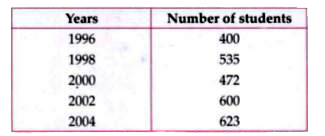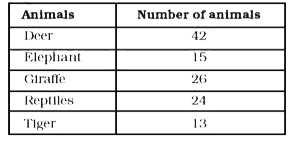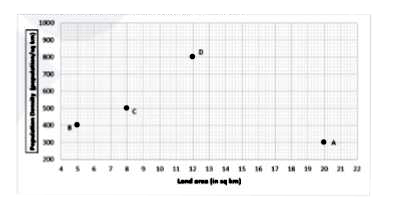Total number of animals in five villages are as follows: Village, Number of animals A B C D E, 80 120 90 40 60 Prepare a pictograph of these animals using one symbol to represent 10 animals.
Step by step video & image solution for Total number of animals in five villages are as follows: Village, Number of animals A B C D E, 80 120 90 40 60 Prepare a pictograph of these animals using one symbol to represent 10 animals. by Maths experts to help you in doubts & scoring excellent marks in Class 6 exams.
Updated on:21/07/2023Topper's Solved these Questions
Similar Questions
Total number of animals in five villages are as follows: Village, Number of animals A B C D E, 80 120 90 40 60 Prepare a pictograph of these animals using one symbol to represent 10 animals.
View SolutionTotal number of animals in five villages are as follows :
Village A : 80Village B : 120Village C : 90Village D : 40Village E : 60
Prepare a pictograph of these animals using one symbol to represent to animals and answer the following questions :
to represent to animals and answer the following questions :
How many symbols represent animals of village E ?
View Solution
Knowledge Check
Blood osmolalities and the adaptable ranges of environmental salinities of two types of animals are shown in the graph below. Mark the correct descriptions of these animals.
A. Type I animals maintain more or less stable internal osmolality by physiological means.
B. Type II animals maintain blood osmolality within narrow physiological ranges un der different salinity conditions.
C. Type I animals are not likely to be found in estuaries or river mouths wher e fresh and salt water meet and the salinity fluctuates greatly.
D. Type II animals gain and lose water at equal rates and have no need to expend energy expelling water or salt from the body.
 AA and BBB and CCC and DDA and D
AA and BBB and CCC and DDA and D
Total number of animals in five villages are as follows :
Village A : 80Village B : 120Village C : 90Village D : 40Village E : 60
Prepare a pictograph of these animals using one symbol to represent to animals and answer the following questions :
to represent to animals and answer the following questions :
Which village has more animals : village A or village C ?
View SolutionTotal number of animals in five villages are as follows :
Village A : 80Village B : 120Village C : 90Village D : 40Village E : 60
Prepare a pictograph of these animals using one symbol to represent to animals and answer the following questions :
to represent to animals and answer the following questions :
Which village has the maximum number of animals ?
View SolutionTotal number of students of a school in different years is shown in the following table: Year, No. of Students 1996 1998 2000 2002 2004, 400 550 450 600 650 Represent the above data by a pictograph. Prepare a pictograph of students using one symbol an icon of a student to represent 100 students and answer the following questions: How many symbols represent total number of students in the year 2002? How many symbols represent total number of students in the year 1998? Prepare another pictograph of students using any other symbol each representing 50 students. Which pictograph do you find more informative?
View SolutionTotal number of students of a school in different years is shown in the following table.

Prepare another pictograph of students using any other symbol each representing 50 students. Which pictograph do you find more informative ?
View SolutionThe following data represents the different number of animals in a zoo. Prepare a pie chart for the given data.

View SolutionThere are some parrots and some tigers in a forest. If the total number of animal heads in the forest is 858 and the total number of animal legs is 1846, what is the number of parrots in the forest? (a) 800 (b) 833 (c) 845 (d) Cannot be determined (e) None of these
View SolutionStudy the following information carefully and answer the given questions:
In the diagram, Population Density (in population per square kilometer) and Land Area (in square kilometer) of 4 villages A, B, C and D for the year 2001 is given.
Population Density of a village = Total population of the village / Area (in square km) of the land of the village Gender Ratio of a village = (Total number of males in a village/Total number of females in a village) × 100

Gender ratio of village C is 125 less than that of A . If female population of villages A and C are equal, then find the male population in village A
View Solution
